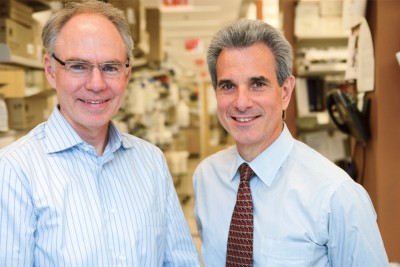
Charles Sawyers (left) and Howard Scher
A team of researchers led by Memorial Sloan Kettering physician-scientist Charles L. Sawyers has reported on the preclinical development and early results from the first clinical trial of a promising new drug for prostate cancer.
The drug, known as MDV3100, is a targeted therapy that was developed to treat castration-resistant prostate cancer (CRPC), the most advanced form of the disease, which kills about 29,000 men in the United States every year.
The male hormone testosterone and other androgens fuel the growth of prostate tumors, and one of the standard treatments for metastatic disease (cancer that has spread beyond the initial tumor site to other parts of the body) is drugs that stop the production or block the action of androgens, which is the equivalent of castration. Initially most patients respond, but eventually their disease progresses despite continuing treatment. Earlier work by Dr. Sawyers, Chair of Memorial Sloan Kettering’s Human Oncology and Pathogenesis Program, and colleagues carried out with both mouse models and patient samples determined that the reason for drug resistance was an increase in the tumor’s production of androgen receptors.
“When we began looking for new compounds, we screened them in cell lines that were engineered to have high levels of the androgen receptor,” Dr. Sawyers explained. “We used a rational design strategy when making new molecules, and, by taking advantage of prior chemistry work that had been done, we were able to develop compounds that bound tightly to the androgen receptor and at the same time inhibited it.” The chemistry work was done by Michael Jung of the University of California, Los Angeles, where Dr. Sawyers worked for many years and did much of his early research on prostate cancer before coming to Memorial Sloan Kettering in 2006.
The current study, published in the May 8 issue of Science [PubMed Abstract], reports that two compounds, RD162 and MDV3100, were effective at inducing tumor shrinkage in mouse models of CRPC that have an increased number of androgen receptors. The two drugs, which are given orally, were shown to reduce the size of tumors and increase the time it took for the disease to progress. According to Dr. Sawyers, because the two compounds are so similar, clinical evaluation is being pursued with only one of them, MDV3100. Development of the drug has been licensed by the biotechnology company Medivation, Inc.
The Science paper also reported on a Phase I/II clinical trial of MDV3100, which was designed to determine the optimal dose for the drug in patients and make sure there are no harmful side effects. The researchers found that for nearly half of the patients (13 out of 30), blood levels of prostate-specific antigen (or PSA, a well-established marker for prostate cancer) dropped by 50 percent or more. According to Dr. Sawyers, the drug caused fatigue at higher doses, but caused few side effects at lower doses, which were ultimately determined to be just as effective.
“This research is a model of how collaboration between basic and clinical science should work,” said Howard I. Scher, Chief of the Genitourinary Oncology Service in Memorial Sloan Kettering’s Department of Medicine and principal investigator of the clinical trial. “Clinicians treating the disease discerned that the androgen receptor was an important target. In the laboratory, we found that overexpression of the androgen receptor was a common feature of tumors that were progressing despite hormone therapy, and one that accelerated tumor growth. Based on this, we developed a drug that is active specifically in laboratory models of prostate cancers with high levels of androgen receptors and have now completed a clinical trial that showed significant activity.” (Dr. Scher presented the research at the American Society of Clinical Oncology’s 2009 annual meeting.)
Dr. Scher will be leading a Phase III clinical trial that will enroll 1,200 patients at centers around the world. The study will compare MDV3100 to placebo in patients whose disease has progressed after treatment with other hormone therapies and chemotherapy to determine whether it prolongs survival.
In a related study, published in Nature Genetics in May, Dr. Sawyers’ laboratory reported new findings about two previously known gene mutations and how they work together in the development of prostate cancer. The first, TMPRSS2-ERG, which is a fusion of the genes TMPRSS2 and ERG, was already shown to be present in about half of all prostate cancers, but it was unknown what role the gene played in the formation of prostate tumors. Using mouse models, the group showed that the gene works in cooperation with another gene mutation, one in the tumor suppressor PTEN. Of note, TMPRSS2-ERG is regulated by the androgen receptor and can be blocked by MDV3100.
This knowledge will help in the creation of better mouse models that more closely mimic the way prostate cancer forms and changes in human patients, providing a better understanding of how to develop additional targeted therapies for the disease and creating a system for testing possible new drugs.


